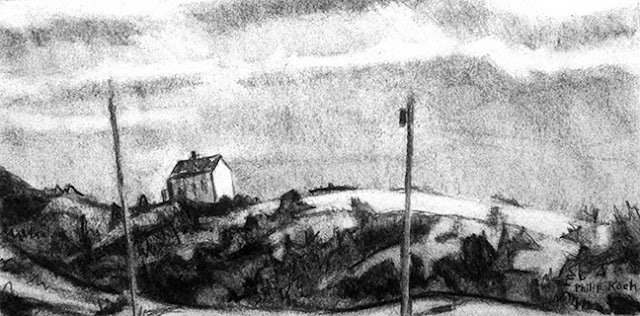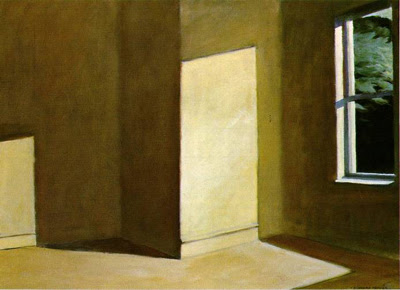The Excitement of Jean Michel Basquiat
A few years ago I attended a talk given by a leading figure at one of New York's most prominent auction houses. It was sponsored by the Baltimore Museum of Art which had asked him to come down and speak about the comtemporary art market. He had a lot of Jean Michel Basquiate paintings coming up at his next auction, so he naturally included that artist's work in his talk. When he came to the Basquiats he commented to the audience "My hedge fund managers really eat up the Basquiats."
Proabably so. Basquiat was a young artist who fell in with Andy Warhol and managed for a few years to get into the headlines. Then a heroin overdose took him. Below are two paintings by earlier artists, George Inness and Caspar David Friedrich, two 19th century landscape painters. What do they have in common with Basquiat? At first glance, not much.
Well, beyond all the paintings being made with paint, they share a few other traits. All three place dramatic large dark shapes against lighter background planes. Basquiat shows what looks like a black skull at the left and two indecipherable black spots at the right. Inness counterposes a silhouetted pine at the left and a spindly thin tree trunk at the right against his pale snow and copper sky. And Friedrich places three wistful figures against a lighter cool moonlit sea.
The Basquiat canvas is larger than the other two put together. It has an immediate, impatient quality to its execution. Basquiat paintings always remind me of a hastily assembled pizza where the ingredients haven't had time to get to know each other yet. In a way the almost "you-can't-believe-how-casual-my-painting-is" stance of the painter is purposeful. I honestly think the artist intended it to hit you like a slap in the face.
Is there a place for art like that? Well, I do know there have been at least a few times in my life where I've been slapped, and sometimes I needed that. But that's not a sensation one seeks out again and again.
(Maybe the hedge fund managers who collected Basquiat unconsciously wanted to be either awakened with a slap or wanted some abuse). In a way contemporary life can hit you like a slap in the face, and Basquiat is like a painting metaphor for that. Still I confess I would grow tired of a Basquiat in my collection pretty quickly. He starts with quite an impact, but once his slap is over, there's not much a a second act.

The George Innes above is admittedly a far quieter painting than the Basquiat. While it doesn't shout at you there is a expressive power in its whispered restraint. Inness does two critical things that Basquiat doesn't get around to. The Basquiat tries to leap off the wall at you. Instead Inness is deeply invested in pulling the viewer into the space of the landscape. One of his key tools is spendng lots of time mixing countless gradations of his colors and tones. The snow that starts out a crisp white in foreground imperceptably shifts itself over to darker and cooler greys and way in the distance even hints of violet. So too Innesses' sky, a color that's actually remarkably intense and slightly surprising as a color choice. Inness carefully sneaks in little shifts in its temperature and tones to make it feel penetrable and atmospheric. Yet at the same time it contrasts the cool snow with a sharp drama.
The other tool Inness gets great mileage out of is his variety of edges. In the Basquiat there's not time to adjust the quality of the edges- the artist puts it down once and leaves it to dry. As a result every edge is the same. With Inness there's no knowing ahead of time how he's going to present a form. Will it crisply delineate itself from its neighbors like the tall tree trunk at the right? Will it be half lost in atmosphere like the suggestive blurrs that form the grey foliage on the horizon? Or will it be a mixture of both as in the prominent pine at the left? What I find so intriguing about this Inness is he seduces you into wanting to explore the painting to see how he treated each form- you don't know ahead of time what he's going to do. You want to go and see for yourself.
Basquiat, in his determination to paint at lightning speed, pretty much dispenses with such mystery.
Is there a place for a painter like Basquiat? Maybe so, even if only because it will allow museum curators in the next century to say things like "Let me show you what the hedge fund managers back in the early 2000's were excited by." Sure, I'm ribbing the Basquiat collectors. And in my own art collection the space reserved for the Basquiats would be pretty small.
In a way arguing about painting is a little like arguing about food. My wife and daughter love artichokes. To me they taste like chalk. Who's right? So if someone really wants Basquiat in their life, who am I to tell them they're wrong? What makes more sense I think is to spend most of my energy making the most important, expressive paintings I can. And on the side telling people why I find an artist like George Inness to be so exciting.
Here's another landscape below by Friedrich that does the same wonderful things with gradation and variety of edges as the Inness. I like them both a lot. Will I ever come to like the Basquiats? It could happen, right after I ask for a second helping of fresh, steaming artichokes.




